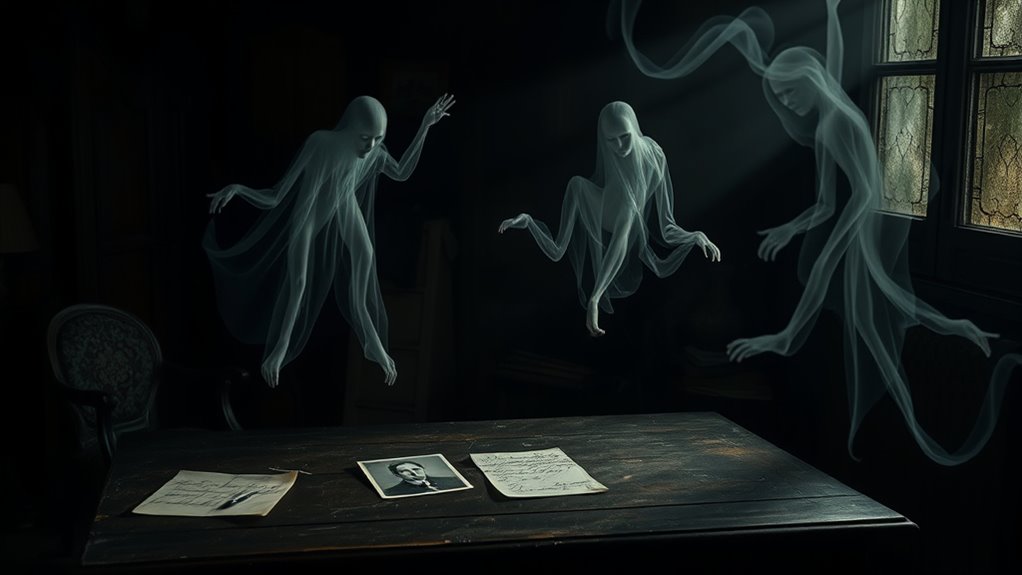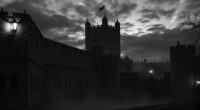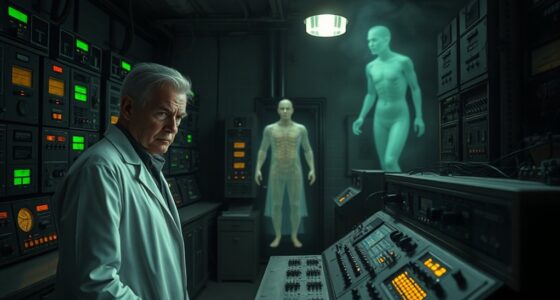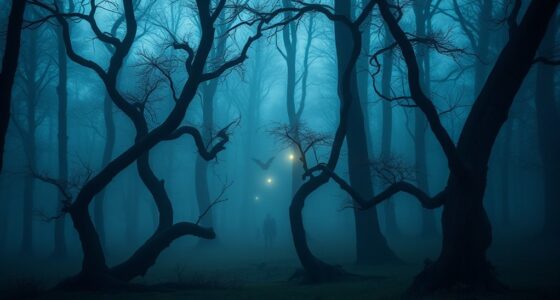The Philip Experiment was created in the 1970s by researchers and the Toronto Ghost Study Group to test if belief alone could produce paranormal effects. They invented a detailed ghost story about a man named Philip, using visualization and collective imagination. By focusing on this fiction, they hoped to see if spectral phenomena would appear naturally. If you’re curious about how scientists manipulated perception and what it reveals about belief and illusions, there’s more to discover ahead.
Key Takeaways
- The Philip Experiment was a 1970s parapsychology study where researchers created a fictional ghost to test belief-induced phenomena.
- Participants developed a detailed backstory for “Philip” and used visualization and meditation to manifest spectral illusions.
- The experiment aimed to explore whether collective imagination and psychological focus could produce paranormal-like phenomena.
- Critics argue the phenomena were likely psychological tricks or suggestion, not actual spirits, emphasizing scientific skepticism.
- The experiment highlighted how belief and perception influence spectral experiences, raising ethical and methodological considerations in paranormal research.
The Origins of the Experiment
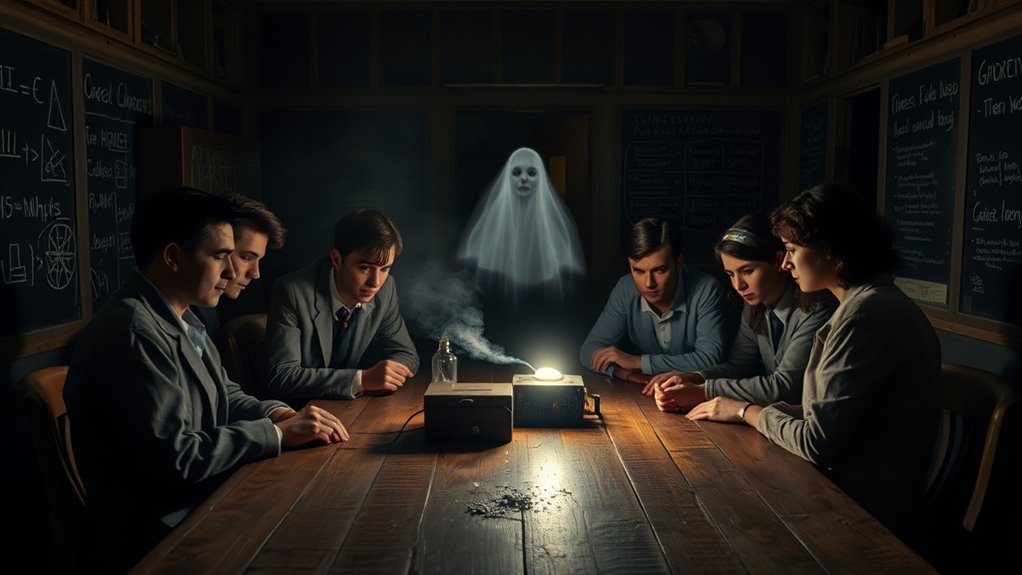
Have you ever wondered how researchers first attempted to tap into the supernatural through science? It all began with an interest in spectral illusions—visual phenomena that seemed to reveal ghostly presence but could be explained away with skepticism. During the early 1970s, a group of researchers sought to challenge paranormal skepticism by creating a ghost story from scratch. They believed that if they invented a spirit and convinced themselves of its reality, they could observe whether supernatural phenomena would manifest. This idea led to the Philip Experiment, where the team aimed to produce a convincing ghost through mental focus and collective belief. Their goal was to explore whether belief alone could generate paranormal activity, blurring the line between imagination and spectral illusions. According to retail hours, understanding the context of specific times and environments can be crucial in experimental settings. Additionally, they hypothesized that collective imagination might play a role in manifesting spectral phenomena, aligning with the psychological aspects of belief.
The Group Behind the Initiative

You learn that the Philip Experiment was driven by a team of parapsychology researchers, including members from the Toronto Ghost Study Group. These experts collaborated with experimental psychologists to design and conduct the project. Their combined efforts aimed to explore the boundaries of consciousness and the possibility of communicating with spirits. The project also exemplifies how research methodologies can be applied to investigate paranormal phenomena scientifically. Additionally, the researchers maintained transparency about their affiliate disclosures to ensure ethical practices throughout the study. Recognizing the importance of emotional support, the team aimed to approach the experiment with sensitivity to the potential psychological effects on participants. Incorporating rigorous scientific procedures helped to validate their findings and maintain credibility in their research. Understanding psychological resilience was also critical to safeguard participants from adverse effects during the study.
Parapsychology Researchers’ Team
Who exactly formed the team behind the Philip Experiment remains somewhat of a mystery, but what’s clear is that it was made up of dedicated parapsychology researchers committed to exploring human consciousness. These scientists aimed to understand ghostly illusions and whether spirits could be conjured through mental focus. They prioritized research ethics, ensuring their methods were respectful and controlled. The team worked collaboratively, blending skepticism with curiosity to test their hypotheses. To illustrate their approach, consider this table:
| Role | Focus Area | Approach |
|---|---|---|
| Lead Researcher | Human consciousness | Controlled experiments |
| Assistant Researchers | Ghostly illusions | Observation and documentation |
| Ethics Coordinator | Research integrity | Safe, respectful procedures |
This team’s dedication was key to the experiment’s meticulous design. Additionally, the importance of attention in their work underscores how sustained focus can influence the outcomes of such sensitive investigations. They also examined how conscious intention might affect the manifestation of ghostly phenomena, highlighting the complex relationship between mind and perception. Furthermore, understanding the role of psychological factors was essential in interpreting their results accurately. Recognizing the significance of AI security vulnerabilities can help improve safeguards against potential misuses of emerging technologies. Moreover, considering the ethical implications of such experiments ensures responsible research practices are maintained.
Toronto Ghost Study Group
The Toronto Ghost Study Group emerged as a dedicated collective of researchers and enthusiasts committed to exploring paranormal phenomena within the city. You become part of a community focused on understanding ghostly illusions and questioning supernatural skepticism. The group conducts investigations, collecting evidence and analyzing encounters with supposed spirits. Their goal isn’t to confirm the existence of ghosts but to examine the psychological and environmental factors behind paranormal reports. You’ll find that the group emphasizes scientific inquiry, often challenging sensational claims and encouraging critical thinking. By engaging in discussions and fieldwork, you gain insight into how cultural beliefs and perceptual biases influence ghost sightings. They also consider environmental factors, such as light, sound, and atmospheric conditions, which can contribute to paranormal experiences. Additionally, understanding projector technology and environmental influences helps explain some illusions mistaken for supernatural activity. Recognizing perceptual biases as part of the investigation process allows the group to better understand why some individuals interpret natural phenomena as paranormal. Ultimately, the Toronto Ghost Study Group aims to demystify paranormal experiences, bridging skepticism with open-minded exploration.
Experimental Psychologists’ Collaboration
Experimental psychologists have played a pivotal role in shaping the Philip Experiment, a deliberate effort to test whether a collective imagination could produce measurable paranormal phenomena. They collaborated closely, designing an experimental methodology to explore ghostly manifestations through controlled settings. These psychologists believed that by applying scientific rigor, they could determine if a haunting was a product of suggestion or genuine supernatural activity. Their teamwork involved developing detailed backstories for the ghost, guiding participants’ expectations, and observing any resulting phenomena. This collaboration allowed them to refine their approach, ensuring that their methods minimized bias and placebo effects. Ultimately, their joint efforts aimed to see if collective belief alone could manifest ghostly manifestations, pushing the boundaries of traditional experimental psychology into the sphere of the paranormal.
Crafting the Myth of Philip
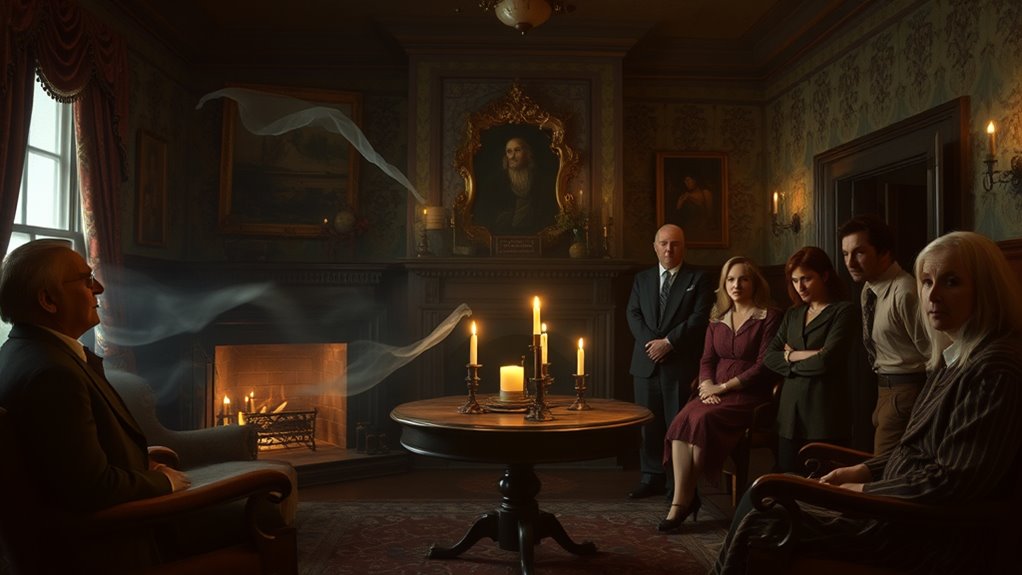
To craft the myth of Philip, the researchers deliberately constructed a detailed background story that would make the entity seem believable. They engaged in myth creation by inventing a plausible life history, personal details, and a backstory that connected Philip to a specific time and place. This careful fabrication aimed to make the spirit feel authentic to those involved. At the same time, they navigated research ethics by ensuring their deception didn’t harm anyone or deceive beyond the experiment’s scope. By creating a compelling narrative, they increased the chances of the ghost manifesting as predicted. The myth’s authenticity was essential, as it provided a foundation for the experiment, blurring the lines between reality and fiction in pursuit of understanding the paranormal.
The Methods Used to Manifest the Spirit

Researchers believed that focused mental intention and group concentration could influence the environment to manifest the spirit of Philip. To achieve this, they employed techniques rooted in scientific methodology, aiming to observe psychic phenomena objectively. As you participate, imagine the room filled with focused individuals, eyes closed, minds aligned. They used specific methods to facilitate spirit manifestation, including:
- Guided visualization exercises to deepen concentration
- Group meditation sessions to synchronize mental states
- Repetitive affirmations to reinforce intent
- Recording tools like electronic devices to capture anomalies
These methods aimed to bridge psychology and paranormal investigation, testing whether collective mental effort could produce observable psychic phenomena. The experiment relied on disciplined mental focus, minimizing external distraction, to bring the fabricated spirit to life through scientific inquiry.
Observations and Unusual Phenomena

You might notice unexplained apparitions appearing during the experiment, leaving you questioning what’s real. Electronic voice phenomena often catch you off guard, with voices that seem to originate from nowhere. These unusual phenomena challenge your understanding of what’s possible beyond the physical domain.
Unexplained Apparitions Appear
Unexplained apparitions often appear suddenly and without warning, leaving witnesses stunned and questioning their senses. These fleeting images can seem eerily real, but sometimes, digital illusions or cognitive biases distort perception. You might see a shadowy figure lurking in the corner, or a translucent face flickering in the mist. The apparition could resemble a loved one, only to vanish when approached. Or perhaps you notice a vague outline that feels strangely familiar. These moments challenge your understanding of reality, making it hard to distinguish between genuine phenomena and illusions born from the mind’s biases. In many cases, what appears is shaped by subconscious expectations or misinterpretations of fleeting visual cues, highlighting how perception can be easily influenced by unseen psychological factors.
Electronic Voice Phenomena
Electronic Voice Phenomena, or EVP, are sounds or voices that appear to communicate from beyond the physical sphere, often captured on audio recordings during investigations. Many skeptics see EVP as a ghost hoax, believing they result from pareidolia or audio artifacts. However, enthusiasts argue these voices provide evidence of spirits or consciousness after death, fueling myth creation around paranormal activity. EVP recordings often contain unintelligible whispers or words that seem to respond to investigators’ questions, adding to the mystery. Yet, the lack of scientific consensus keeps EVP in the realm of unexplained phenomena. Whether real or fabricated, EVP continues to intrigue those seeking proof of life after death, blurring the line between genuine paranormal encounters and manufactured myth.
Skeptical Perspectives and Criticisms
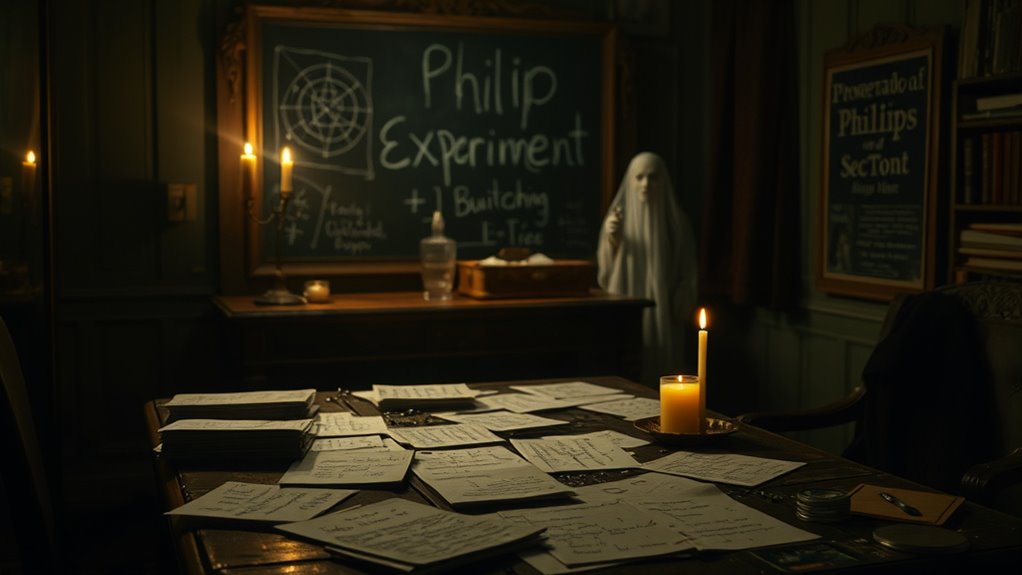
How convincing is the Philip Experiment as evidence of supernatural communication? Skeptics argue it’s more likely a hoax debunking or a product of psychological influences rather than actual spirits. Critics highlight that the entire setup relies on suggestion and expectation, not paranormal phenomena. Visualize the group sitting in a dim room, eyes fixed on the flickering candle, minds enthusiastic for answers. They might have unconsciously guided the responses, influenced by subtle cues. Skeptics point out that the experiment lacked rigorous scientific criticism, and confirmation bias could explain the results. The “ghost” was a construct of conscious and unconscious manipulation, not an authentic supernatural entity. Overall, skeptics see it as a clever psychological trick rather than proof of ghosts.
The Impact on Paranormal Research
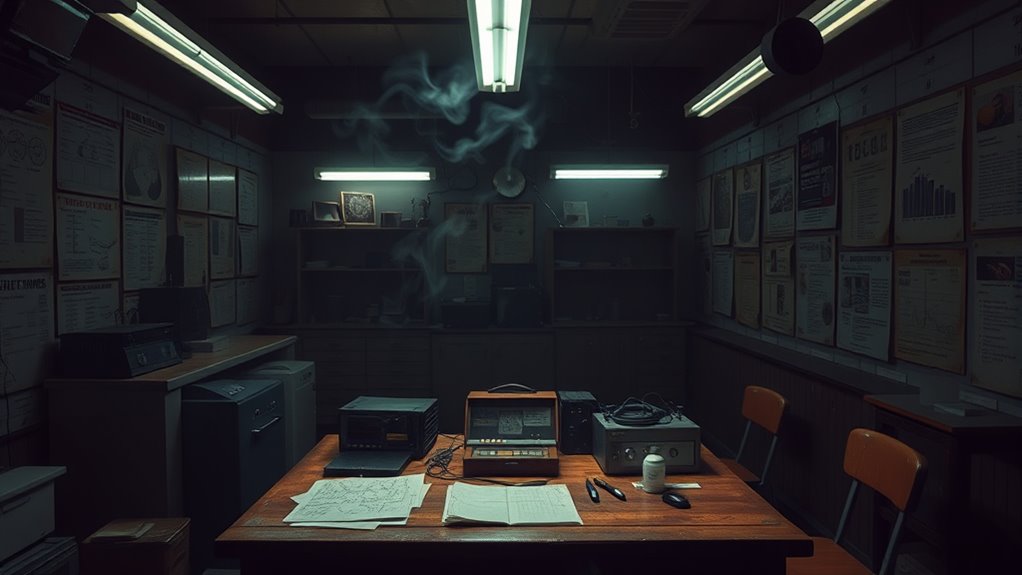
The Philip Experiment considerably influenced the direction of paranormal research by challenging assumptions about the nature of ghostly phenomena. It prompted researchers to question whether paranormal events could be artificially created or manipulated, shifting focus toward experimental approaches. However, it also drew criticism from scientific skeptics who saw it as undermining the credibility of genuine investigations. The media sensationalized the experiment, often exaggerating its implications and fueling public belief in ghosts. This mix of curiosity and skepticism pushed the field to reconsider methodologies and seek more rigorous proof. While some viewed it as a breakthrough, others saw it as a cautionary tale about the importance of scientific skepticism in paranormal research. Overall, the experiment highlighted how media sensationalism can influence perception and the quest for understanding ghostly phenomena.
Psychological Explanations and Theories
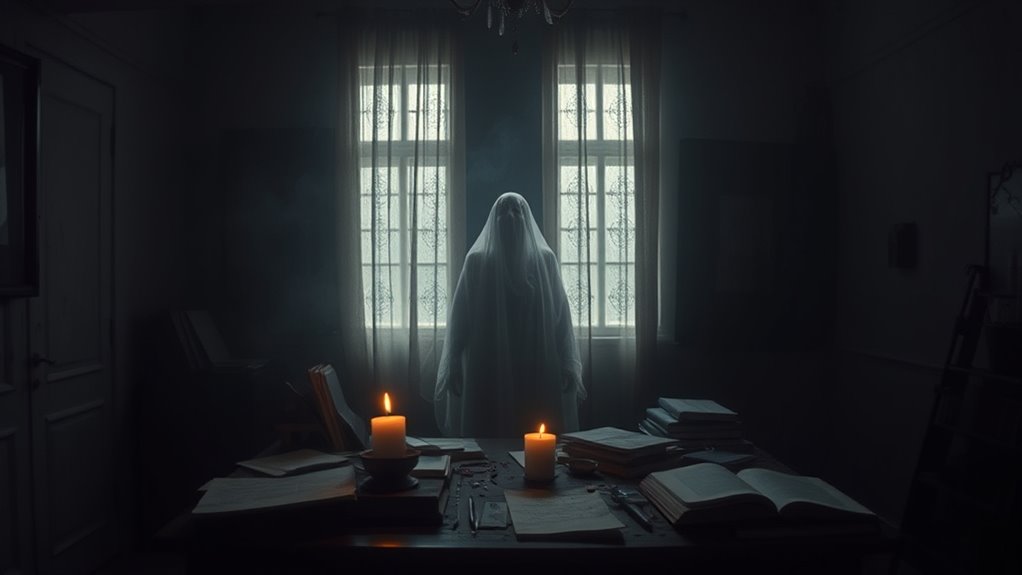
Psychological explanations and theories offer compelling insights into ghostly phenomena by emphasizing the role of the mind and perception. You might experience apparitions or unexplained sounds because of psychological processes like expectation, suggestion, or memory. Cognitive biases, such as confirmation bias, lead you to interpret ambiguous stimuli as paranormal. These biases shape how your brain filters sensory information, sometimes creating the illusion of spirits. Visualize your mind:
- Filling in shadows with familiar faces
- Interpreting creaks as ghostly footsteps
- Misremembering events to fit a supernatural narrative
- Falling victim to suggestion during séances
Cultural and Media Reactions

As you explore the media coverage of the Philip Experiment, you’ll notice a surge in sensationalism that captures public attention. At the same time, cultural skepticism grows, with many questioning the experiment’s legitimacy. This clash shapes how society perceives paranormal claims and influences ongoing debates.
Media Sensationalism Surge
Have you ever noticed how media outlets amplify stories around paranormal experiments like the Philip Experiment? They often sensationalize findings, blurring lines between fact and fiction. This surge in media coverage raises questions about media ethics, as headlines prioritize shock value over accuracy. As a result, public perception becomes skewed, fueling belief in the supernatural. The media’s focus on sensationalism can overshadow rigorous scientific methodology, which demands skepticism and verification. Visualize headlines with bold claims, ghostly images, and dramatic soundbites—creating vivid imagery that captures attention but distorts the truth. This trend can distort scientific efforts, turning experiments into sensational stories rather than credible investigations. Ultimately, it’s up to you to discern responsible reporting from media-driven hype.
Cultural Skepticism Rise
Why does the rise of cultural skepticism influence how you react to paranormal experiments like the Philip Experiment? As skepticism grows, people become more critical of claims rooted in supernatural fiction and less trusting of ghost-hunting tales. This shift pushes audiences to question whether such experiments are genuine or simply elaborate hoaxes. Instead of accepting supernatural explanations, you may see these efforts as attempts at folklore preservation or psychological exploration. Media outlets, influenced by skeptical attitudes, often highlight the potential for deception, encouraging you to view paranormal phenomena as cultural constructs rather than real entities. This cultural skepticism fosters a more cautious approach, making you less likely to believe in spirits without substantial proof and more interested in the social or psychological aspects behind ghost stories.
Lessons Learned From the Experiment

The Philip Experiment offers valuable insights into the power of collective belief and the limits of our understanding of the supernatural. You learn that belief can influence perceptions and experiences, even without supernatural forces. It also highlights the importance of scientific skepticism, reminding you to question claims and seek evidence. Ethical considerations come into focus, emphasizing responsible research and respecting the boundaries of participants.
Imagine:
- A flickering candle casting shadows in a dim room
- An echoing whisper in an empty hallway
- A flickering meter responding to unseen energy
- The quiet anticipation of an imagined presence
These images demonstrate how collective imagination and suggestion can create convincing illusions. Ultimately, the experiment teaches you that skepticism and ethics are vital when exploring the unknown.
Frequently Asked Questions
Did the Philip Experiment Influence Modern Ghost Hunting Techniques?
You might wonder if the Philip Experiment influenced modern ghost hunting techniques. It’s possible, as it highlights the psychological impact of belief and expectation, shaping how investigators approach paranormal claims. However, it also reminds you to watch for researcher burnout, since intense focus can lead to fatigue and false positives. While it didn’t directly create new methods, it encouraged a more skeptical and psychological approach to ghost hunting today.
Were There Any Long-Term Psychological Effects on the Researchers Involved?
Imagine chasing shadows in a dark room—that’s how psychological trauma can linger after intense research. You might not see immediate effects, but long-term, researcher burnout and psychological trauma can develop, impacting mental health. Some researchers report feeling haunted by their experiments, showing that even in controlled environments, deep psychological effects are possible. These lasting impressions highlight the importance of mental health support for those pushing scientific boundaries.
How Did Media Outlets Initially Portray the Experiment’s Success?
You see, media sensationalism initially exaggerated the experiment’s success, making it seem like proof of spirits or ghosts. Many outlets portrayed it as a groundbreaking breakthrough, fueling public fascination. However, you might also notice that some reports sparked skepticism, questioning the scientific validity. This mix of hype and doubt shaped early perceptions, leading people to either believe in supernatural phenomena or see it as clever trickery rather than genuine evidence.
Were Any Other Similar Experiments Conducted After Philip?
Imagine a world where your curiosity pushes boundaries, much like the pioneers of paranormal experiments. After Philip, researchers tried similar projects, exploring ghostly phenomena through thought forms and psychic studies. These experiments aimed to understand or replicate spirits, often inspired by folklore and legends. While some yielded intriguing results, mainstream science remains skeptical, and such projects continue as niche investigations into the mysteries of the supernatural.
What Ethical Considerations Arose During the Experiment’s Planning and Execution?
You should consider that ethical issues like informed consent and researcher bias are vital in any experiment. During planning and execution, you’d need to guarantee participants are fully aware of the experiment’s nature and potential risks. Avoiding researcher bias is also essential to maintain objectivity. These considerations help protect participants’ rights and ensure the integrity of your study, especially when dealing with sensitive or supernatural topics.
Conclusion
You witness how the Philip experiment proves that perception and belief can produce powerful phenomena. By blending boldness with skepticism, researchers demonstrated that crafted conjurations can create convincing clues of the paranormal. This fascinating fiasco offers valuable lessons about the limits of belief, the power of perception, and the importance of scientific scrutiny. Ultimately, it’s a demonstration to how human imagination and inquiry can intertwine, inspiring intrigue and influencing insights into the mysterious world of spirits.
